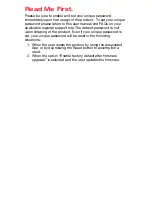
21020285 D
User’s Guide
Chapter 6 Target Mode Pass-through Commands
Page 6 - 8
Command Operation
Sequence of
Events—
Receiving a
command
from an
Initiator
The following sequence occurs when an initiator selects the RF3880:
1.
An initiator selects the RF3880 as a SCSI target device, and sends a
SCSI command.
2.
Using the command data it receives from the initiator, the adapter builds
a Target Selection Data Structure in memory, at the address indicated in
the Target Mode Enable command.
3.
The adapter sets the SAV bit in the Semaphore field of the Target
Selection Data Structure to indicate that a selection has occurred.
4.
The adapter disconnects from the SCSI bus. (The adapter will not
disconnect from the SCSI bus if disconnect privilege is not granted in
the Identify message received from the initiator.)
5.
The adapter interrupts the Host. (The adapter will not interrupt if a
Selection Interrupt Level of zero in the Target Mode Enable command
is used.)
Note
Until the Host responds
to selection (by writing a
2 to the Channel
Attention Port), the
adapter will queue other
selections. Once the
adapter’s queue is full
(approximately 60
selections) the adapter
will respond to any
further selection
attempts by sending a
Busy status to the
initiator(s) trying to
select it
Any errors that are non-recoverable will be indicated in the Target
Selection Data Structure.
6.
The Host must read the Target Selection Data Structure. The Host
should clear the SAV bit in the Semaphore byte of the data structure
after it is read.
7.
The Host must write a 2 to the Channel Attention Port of the adapter to
indicate the data has been read.
8.
The adapter is ready to send another selection area to the Host once it is
selected again by an initiator.
Summary of Contents for Rimfire 3880
Page 1: ...Rimfire 3880 SCSI Host Bus Adapter User s Guide Ciprico Inc Publication No 21020285 D...
Page 2: ......
Page 4: ...21020285 D User s Guide...
Page 25: ...2 H a r d w a r e E s s e n t i a l s...
Page 42: ...21020285 D User s Guide Chapter 2 Hardware Essentials Page 2 18 Descriptions of Port Usage...
Page 43: ...3 H a r d w a r e I n s t a l l a t i o n...
Page 59: ...4 C o m m a n d O p e r a t i o n...
Page 85: ...5 I n i t i a t o r M o d e P a s s t h r o u g h C o m m a n d s...
Page 103: ...6 T a r g e t M o d e P a s s t h r o u g h C o m m a n d s...
Page 125: ...7 B o a r d c o n t r o l C o m m a n d s...
Page 175: ...8 D e t a i l s o f U s a g e...
Page 193: ...A E r r o r C o d e s...
Page 201: ...B C a b l e s a n d C o n n e c t o r s...
Page 206: ...21020285 D User s Guide Appendix B Cables and Connectors Page B 6 VMEbus Connector Pinouts...
Page 207: ...C S p e c i f i c a t i o n s...
Page 210: ...21020285 D User s Guide Appendix C Specifications Page C 4 Specifications...
Page 211: ...D D e f a u l t s...
Page 216: ...21020285 D User s Guide Appendix D Defaults Page D 6 HardwareDefaults...
Page 217: ...E D e s i g n D i f f e r e n c e s...
Page 229: ......
Page 230: ...21020285 D...
















































